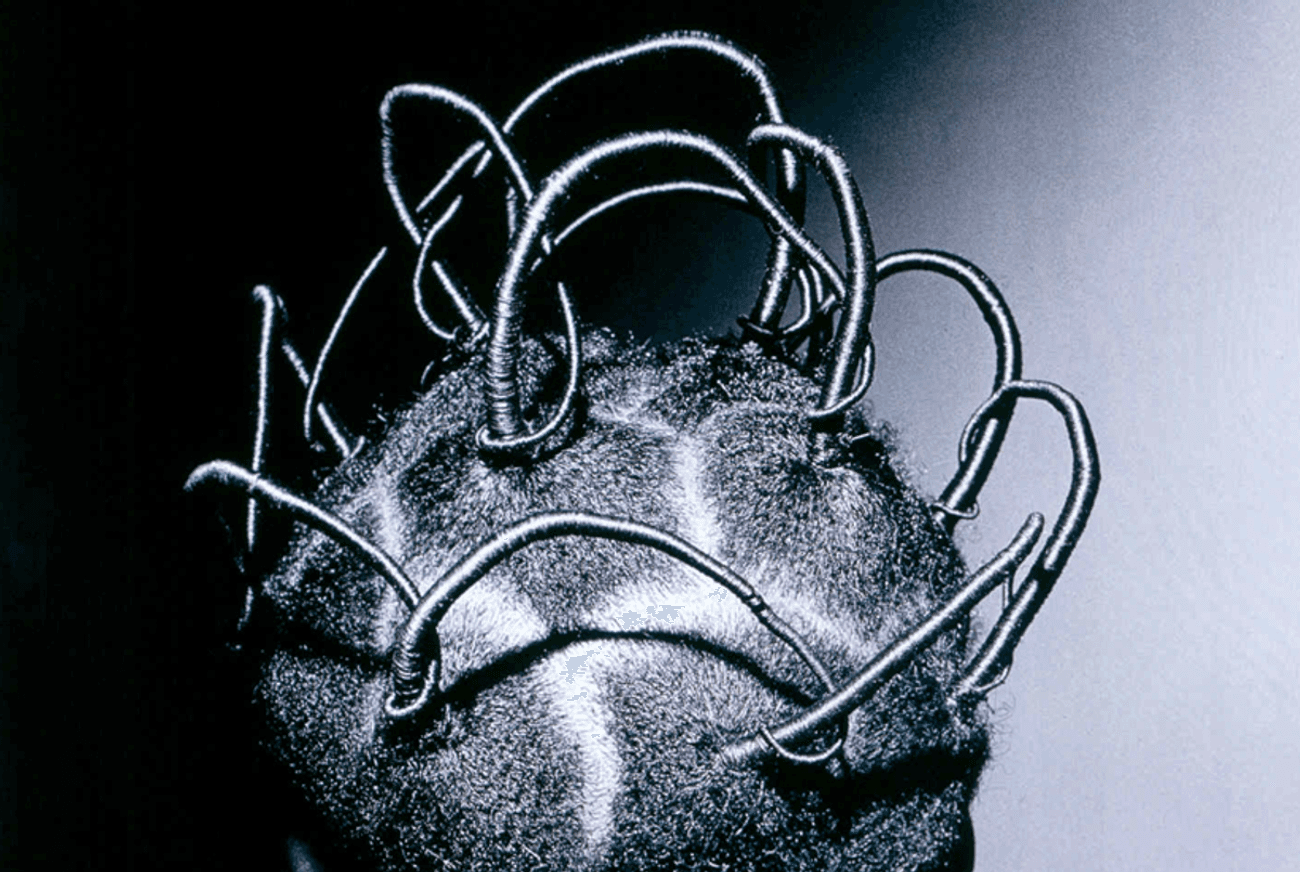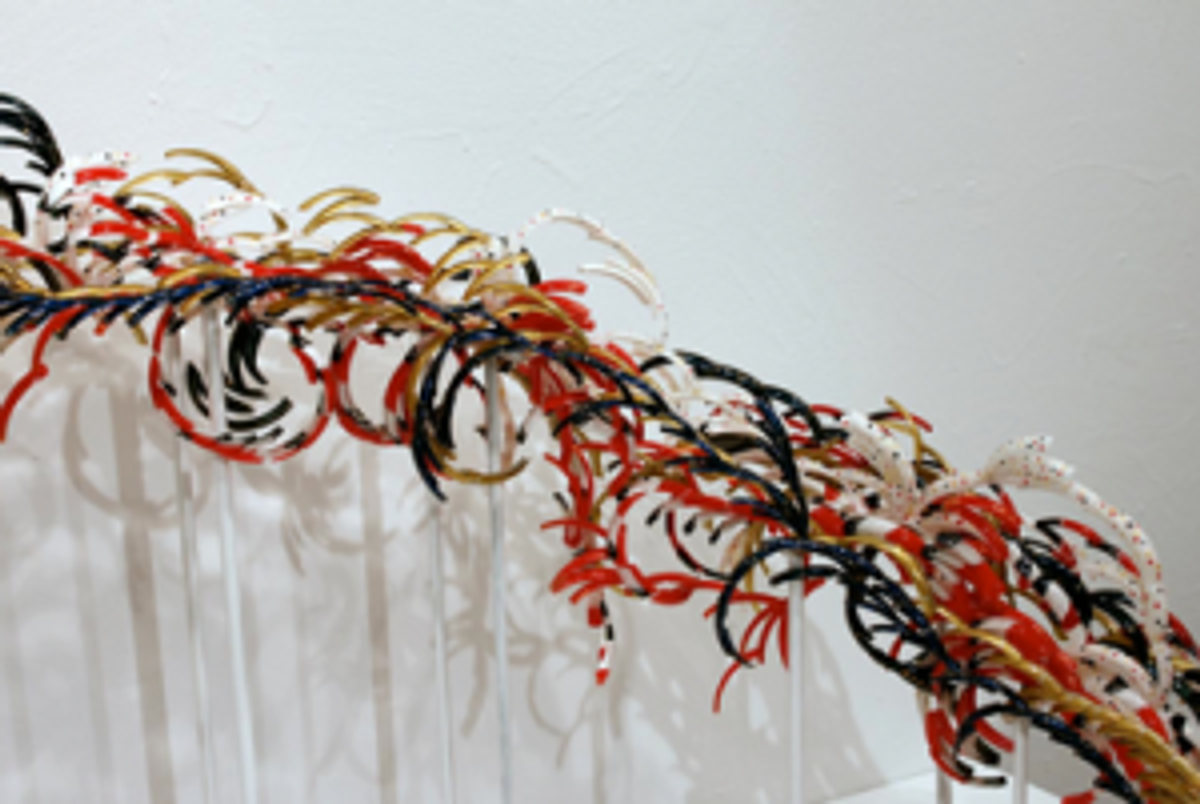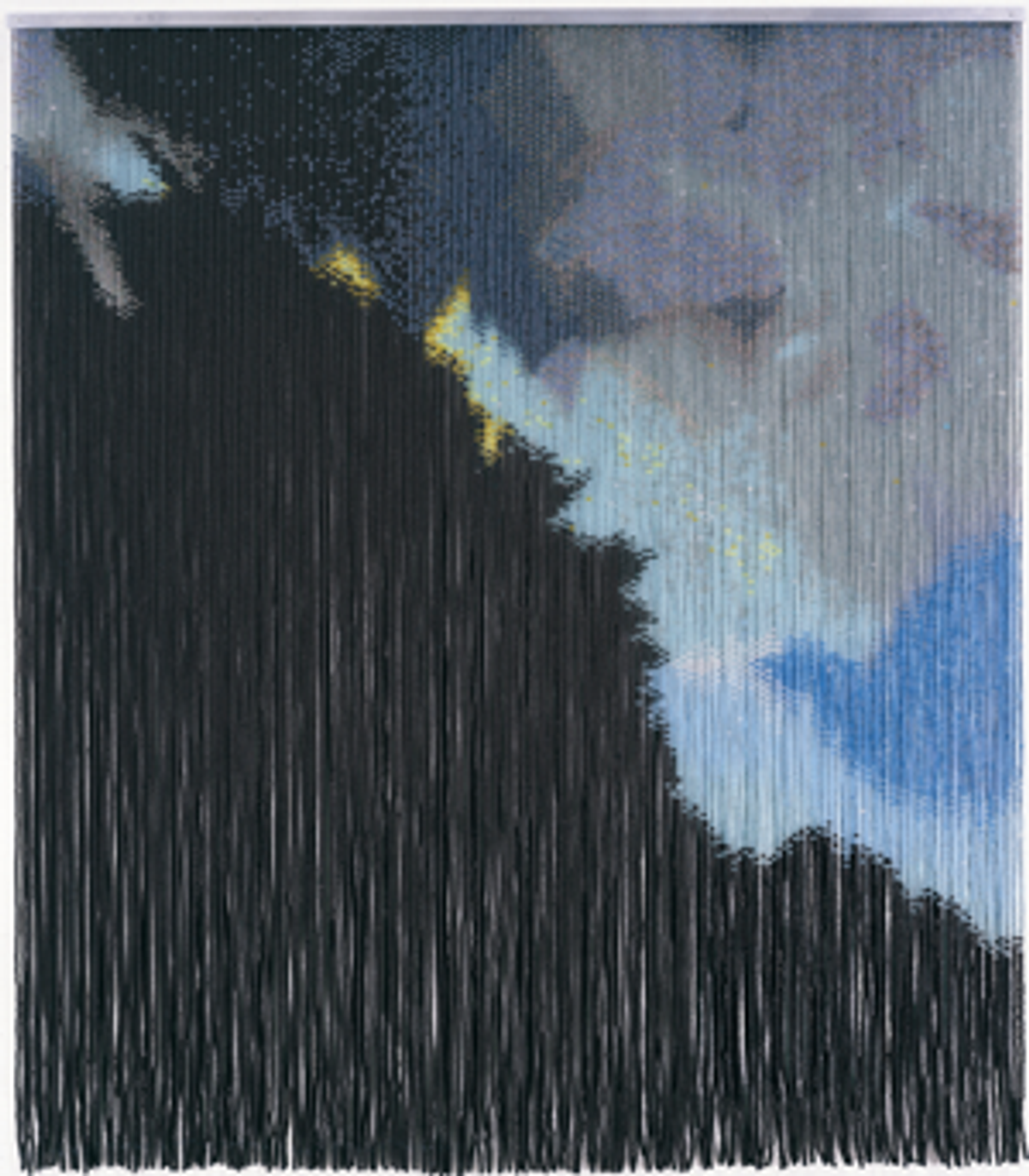The Art of Jewish Hair
A fascinating New York City museum exhibit looks at black women’s hair and nails. Don’t wait for the Jewish version.



Salon Style, a group show at the Studio Museum in Harlem, looks at artists who use black hair, nails, and styling materials to create fine art, or who make black hair and nails the focus of their work. It’s a playful yet intense show that brings up fascinating ideas about cultural identity, commerce, globalism, and the marketing of ethnic pride. It’s a compelling exhibit.
A different museum could, in theory, mount a similar show about Jewish hair. After all, Jewish women also face hair issues tied to identity: Many of us ponder straightening our hair; others face covering their hair with hats, wigs, or even feminine kippot. Jewish men have their own hair issues—from beards to peyes—along with the signifiers that come from tending toward hirsuteness as a people. Hell, Jews even have rules and cultural traditions about when children can get a haircut.
But while I enjoyed Salon Style, I wouldn’t want to see the Jewish version. Because even though Jewish women talk and fret and occasionally make art about our hair, it’s simply not as complicated and loaded a subject—nor as intricately braided into our identity—as it is for black women in America today.
***
Here’s a sampling of what makes the Studio Museum show, running through June 28, so intriguing: A 1995 piece by Chakaia Booker called Repugnant Rapunzel (let down your hair) is a huge, snarled knot made of strips of rubber tires. It evokes twists, braids, and weaves, while at the same time, as the National Museum of Women in the Arts points out, the different treads on the tires themselves “suggest images as varied as African scarification and textile designs” and the choice of medium “references industrialization, consumer culture, and environmental concerns.” A beautiful, gleaming wall-hanging by Kori Newkirk seems to depict a mysterious nighttime landscape silhouetted against a stormy sky … but when you take a step back, you see that you’re actually looking at a curtain made of different tinted plastic pony beads strung on braided synthetic hair and hung from metal brackets. The landscape feels universal while the construction feels specific; the image is natural and wild and without people, while the plastic beads and pre-made hair seem to speak of an entirely different world. Another work, Mark Bradford’s White Noise, uses the squares and rectangles of tissue used as perm endpapers in salons to create a multilayered collage. A former hair stylist, Bradford creates a canvas that evokes city maps, city energy, and city walls with years of wheat-pasted posters and flyers and ads slapped one atop another. Meschac Gaba, an artist from Benin who lives part-time in the Netherlands, contributes a sculpture called Lipstick Building; it brings to mind the tiered, telescoping shape of the iconic midtown Manhattan office building but instead of steel and granite, it’s made of braided artificial hair and dangling coins atop a wooden pedestal. It’s makes one think of a regal African beauty, the business of cosmetics, a commercial building, and a wedding cake—all at once.

My favorite pieces in the show are by Pamela Council, using the medium of fake acrylic nails. Her 2012 FloJo World Record Nails is a tribute to Florence Griffith Joyner’s victories in the 1988 Seoul Olympics. Council recreated the nail designs FloJo wore when she set her (still-standing!) 200-meter record victory and then created a 1:200 scale 3D model of the track constructed out of more than 2,000 curved, painted nails. It’s brightly colored and fun, but also a little jarring and unnerving; the nails curl out at angles from the main track and seem to arch kinetically and impatiently out of the curve of the design. I remember when I was a teenager and FloJo became a sensation; some sports fans spoke disparagingly of her nails as a tacky, frivolous distraction. Council’s work seems to acknowledge the criticism, note the threatened and murky feelings behind it, then push gleefully forward. (I’d also note that in the last couple of Olympics, almost every female athlete seemed to have a patriotic manicure. As with so many African-American celebrities, FloJo’s fashion and beauty choices were greeted with dismay … then widespread adoption.)
Another Council work in the show is Blaxidermy Beauty Supply Nail Sconces. An entire wall of the gallery is covered with life-sized curved brown fingers, mounted on wooden plaques, looking like coat hooks. Each is topped with a long, black, curved acrylic nail with a face on it. The faces’ round white eyes, broad noses, and red lips recall the imagery of minstrel shows and golliwogs. As Council told Bustle magazine, “Blaxidermy is a word I use that combines taxidermy and an idea of blaxploitation. In the series, I used beauty supply products and a lot of sculptural elements that referred to the body. Like blaxploitation, I hope it’s somewhere in the space between comical, outrageous, horrific, and enlightening. And always exuberant.” Isolating the fingers with long nails on a wall makes the act of adornment seem like fine art, but there’s also that unnerving sight of chopped-off fingers hanging on a wall. Given America’s history of violence against black women, there are multiple resonances at play. On her website, Council notes that black women spend 80 percent more per capita than the rest of the population on beauty products, but they also make significantly less on the dollar than white men or even white women. (According to the AAUW, black women make 64 cents and white women make 78 cents to every dollar a white man earns.) So, are beauty and adornment an escape, a money-suck, an obligation, a joy, or a trap?
***
I loved the show, curated by Hallie Ringle, in all its nuance. So, why do I think there shouldn’t be a Jewish equivalent to Salon Style? Jewish women, after all, are hair-obsessive. Tablet has run umpteen stories on Jewish hair—untamed curls, sheitels, head coverings. Last week’s New York Times ran a story on the hair regimens of the different actresses who’ve played the lead in Joshua Harmon’s play Bad Jews. (The script spends an entire paragraph describing what Daphna should look like: “2/3 body, 1/3 hair,” and elaborates: “Thick, intense, curly, frizzy, long brown hair. Hair that clogs a drain after one shower. Hair you find on pillows and in corners of the room and in your refrigerator six months after the head from which it grew last visited. Hair that could not be straightened even if you had four hours and three hairdressers double-fisting blow driers. Hair that screams: Jew.”) One of the actresses in one production talked about how her hair actually broke the brush she was using onstage. “They gave me a Target brand small little brush. But I need a mamajama hairbrush.” Yep, that’s Jewish hair in all its glory. But come on, sister, cry me a river. When it comes to snapped-off hair implements, I got more stories than J.D.’s got Salinger. When I worked in women’s magazines, a famous Korean hairdresser told me I had “hair for five.” I’m hardly alone in that in our culture.

And yes, there have been fine artists who’ve addressed the subject of Jewish hair. My brother, a former curator at the Jewish Museum, pointed me toward British-German-Jewish artist Tanya Ury, whose work includes a coat constructed out of small plastic bags of the artist’s own hair. As Ury writes, “It is an unlikely and unpractical article of clothing—something between being a shower curtain and the contents of a mattress (under Hitler’s dictatorship, the Nazis collected shorn hair of women concentration camp inmates to be used for mattress stuffing).” The coat’s design is based on a German Luftwaffe prototype, which also bears a resemblance to a Hugo Boss coat from the designer’s winter 1998-99 season. Ury calls it a “hair shirt,” a play on the notion of atonement, while noting that Boss came to prominence designing uniforms for the Fascist war machine. (Boss joined the Nazi Party in 1931 and made uniforms for it as well as for the SS, Hitler Youth, and Brownshirts; his factories used forced labor from countries Germany invaded.) In her artist’s statement, Ury writes that her work is intended to raise “profound questions surrounding the relationships between fashion and military fashion, fashion, and politics.”
Chinese artist Wenda Gu created a worldwide art project called United Nations, using the hair of people in different countries in site-specific installations. In his Israel piece, staged in the Mitzpe Ramon desert, the artist created an installation of 30 blocks of pink Jerusalem limestone covered in Jewish hair. I think the permanence of the stone was supposed to interplay with the fragility of the hair and the harshness of the setting to make a statement about Jewish Israelis’ place in the world. But reading about the United Nations project makes me cringe; it seems well-meaning, but culturally oblivious and shallow. Gu’s goal is to capture each country’s identity and history in hair, then to create a giant wall that incorporates everybody’s hair. He writes, “A great ‘utopia’ of the unification of mankind probably can never exist in our reality but it is going to be fully realized in the art world.” Oy. The naivete of “We Are the World,” but with more follicles.
I asked Tablet contributor Robin Cembalest, the former editor at ARTNews who currently blogs about art at Let My People Show, why she thinks there’s so little Jewish-hair-related fine art. After all, Jewish hair and nails are an integral part of the Jewish American Princess stereotype, and there are more essays about Jewish hair out there than any of us can shake a keratin-smoothing flat iron at. She emailed, “I think that for Jewish artists the equivalent of hair in black art is the nose: Society expectations of beauty, straightening, etc.” So yes, while Jewish hair can be an impetus for visual art, it doesn’t as a whole hold the same collective import to us that black hair does for black people. Individual Jews who have big-hair-related mishegas or who live in communities in which covering one’s hair is normative write essays about Jewish hair. But as a people, our hair is as diverse as we are. We’ve been in exile and scattered to the winds for thousands of years, and our hair is black hair, blonde hair, straight hair, curly hair.
Sure, Jewish hair is often seen as wild and unmanageable and sexual and undisciplined because of this classic Middle Eastern-looking stereotype, but a) plenty of us don’t have that hair, and b) we simply aren’t faced with the same kinds of decisions—to straighten, process, braid, twist, or go natural—that black women face. Schools and workplaces don’t have rules about what Jewish hair can look like. Choosing to go natural and choosing to process don’t have the same cultural resonanaces about embracing one’s true beauty and selfhood or absorbing white beauty standards. And look, most of us are white. (For those of us who aren’t Jewishness is not generally the aspect of identity that informs their hair choices, beyond the choice to cover one’s head.) White Jews can often pass for white non-Jews. Right now, straightening is en vogue, but in the not-so-distant past (the 1980s of my own youth!), goyish women actually got curly perms, as if they wanted to emulate us.
Cembalest is right. For us, the nose is the hair. In the seminal 1996 Jewish Museum show Too Jewish? Dennis Kardon’s piece “Jewish Noses”—a vast assortment of casts of, well, Jewish noses—clearly considered the nose the key physical identifier. In anti-Semitic cartoons, the one thing all we greasy or slutty Hebraic types have in common is a giant schnozz. Rhonda Lieberman’s awesome Barbie-related work, which points out that this paragon of shiksa-goddess-dom was created by a Jewish woman, looks at the whole boobtacular package: Barbie is the ideal California girl—the straight blonde hair, yes, but also the snub nose, the giant and innocent blue eyes, the impossibly slender and leggy body. Lieberman’s Too Jewish? piece, “Barbra Bush,” on the other hand, canonizes Barbra Streisand, queen of the great big nose, juxtaposing her with a Christmas tree. It’s all about that nose, ‘bout that nose, no treble. The hair isn’t the thing. And for us to blow it into something bigger than it is—much like using thickening lotion, a bottle of Tresemmé and an old-school Conair dryer—would be wrongheaded.
***
Like this article? Sign up for our Daily Digest to get Tablet Magazine’s new content in your inbox each morning.
Marjorie Ingall is a columnist for Tablet Magazine, and author of Mamaleh Knows Best: What Jewish Mothers Do to Raise Successful, Creative, Empathetic, Independent Children.
Marjorie Ingall is a former columnist for Tablet, the author of Mamaleh Knows Best, and a frequent contributor to the New York Times Book Review.